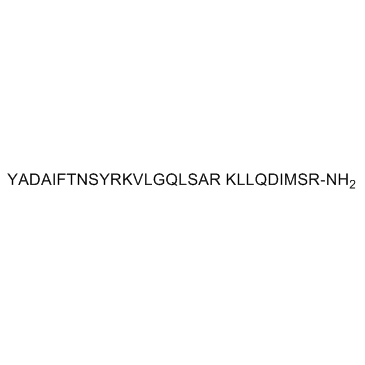GHRH antagonist when combined with cytotoxic agents induces S-phase arrest and additive growth inhibition of human colon cancer.
Ferenc G Rick, Stephan Seitz, Andrew V Schally, Luca Szalontay, Awtar Krishan, Christian Datz, Andreas Stadlmayr, Stefan Buchholz, Norman L Block, Florian Hohla
Index: Cell Cycle 11(22) , 4203-10, (2012)
Full Text: HTML
Abstract
Treatment of colon cancer with an antagonist of growth hormone-releasing hormone (GHRH), JMR-132, results in a cell cycle arrest in S-phase of the tumor cells. Thus, we investigated the effect of JMR-132 in combination with S-phase-specific cytotoxic agents, 5-FU, irinotecan and cisplatin on the in vitro and in vivo growth of HT-29, HCT-116 and HCT-15 human colon cancer cell lines. In vitro, every compound inhibited proliferation of HCT-116 cells in a dose-dependent manner. Treatment with JMR-132 (5 μM) combined with 5-FU (1.25 μM), irinotecan (1.25 μM) or cisplatin (1.25 μM) resulted in an additive growth inhibition of HCT-116 cells in vitro as shown by MTS assay. Cell cycle analyses revealed that treatment of HCT-116 cells with JMR-132 was accompanied by a cell cycle arrest in S-phase. Combination treatment using JMR-132 plus a cytotoxic drug led to a significant increase of the sub-G 1 fraction, suggesting apoptosis. In vivo, daily treatment with GHRH antagonist JMR-132 decreased the tumor volume by 40-55% (p < 0.001) of HT-29, HCT-116 and HCT-15 tumors xenografted into athymic nude mice. Combined treatment with JMR-132 plus chemotherapeutic agents 5-FU, irinotecan or cisplatin resulted in an additive tumor growth suppression of HT-29, HCT-116 and HCT-15 xenografts to 56-85%. Our observations indicate that JMR-132 enhances the antiproliferative effect of S-phase-specific cytotoxic drugs by causing accumulation of tumor cells in S-phase.
Related Compounds
| Structure | Name/CAS No. | Molecular Formula | Articles |
|---|---|---|---|
 |
Sermorelin
CAS:86168-78-7 |
C149H246N44O42S |
|
Neurotransmitter-mediated action of an antagonist of growth ...
2012-07-15 [Behav. Brain Res. 233(1) , 232-6, (2012)] |
|
Inhibitory effects of antagonists of growth hormone-releasin...
2013-02-15 [Int. J. Cancer 132(4) , 755-65, (2013)] |
|
Novel antagonists of growth hormone-releasing hormone inhibi...
2012-02-01 [Cancer 118(3) , 670-80, (2012)] |
|
Effects of the growth hormone-releasing hormone (GH-RH) anta...
2011-10-10 [Behav. Brain Res. 224(1) , 155-8, (2011)] |
|
Growth hormone releasing hormone (GHRH) signaling modulates ...
2013-11-01 [J. Neurochem. 127(4) , 531-40, (2013)] |